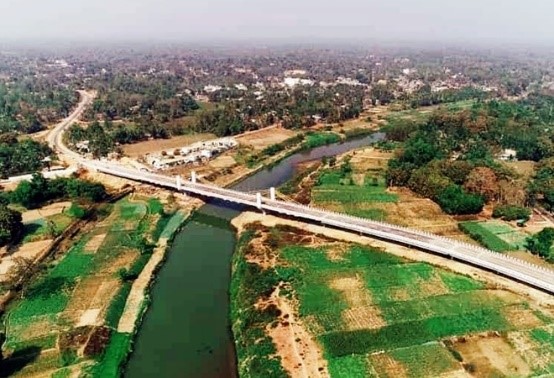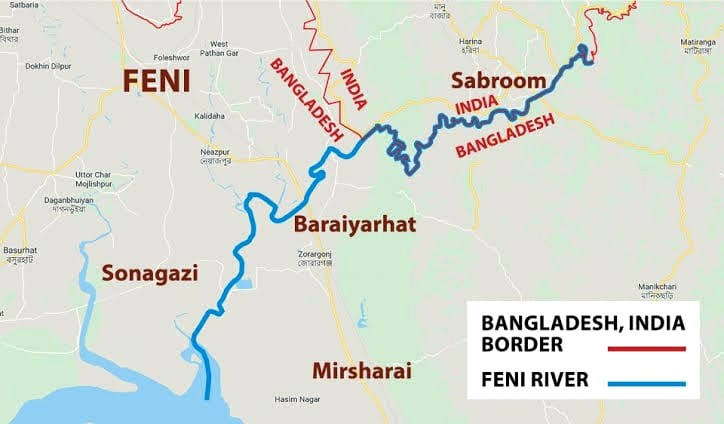Description

Disclaimer: Copyright infringement not intended.
Context
- The Maitri Setu connecting Sabroom is set to become operational from September 2023.
Maitri Setu
- Maitri Setu (lit. friendship bridge) is a 150-metre (490 ft) bridge on the Feni River that links Tripura in India with Chittagong port in Bangladesh.
- Thus, it provides a shorter and more economical alternate land route between India's eastern and western states compared to the longer route through Assam.

Significance
- The opening of the Maitri Setu connecting Sabroom in Tripura and Chittagong port will give India’s northeastern region and landlocked countries like Bhutan and Nepal access to the Bay of Bengal.
- This will significantly boost connectivity, development and security in the region.
- The bridge place a very important economic role as a major trade route to Northeast India, with access to Chittagong Port, which is just 80 kilometers from the border.
- The land route between Agartala and Kolkata Port through this bridge is just 450 km via Bangladesh compared to the 1600 km land route via Siliguri Corridor.
- Logistics cost from Agartala to Kolkata Port will be 80% lower, as compared to the Siliguri Corridor, if the goods are sent through this bridge via Chattogram Port 200 km away
- Chittagong port is just around 80 km away from Tripura's last border town Sabroom and can be covered by road in two-and-a-half hours. The opening of Maitri Setu will further boost connectivity with India’s strategic northeastern region.
- With the opening of this bridge, apart from India’s northeastern region, other landlocked countries in the region like Bhutan and Nepal will now get access to the Bay of Bengal.
- Connectivity is vital for the development of every country in the Indo-Pacific region.
Other Strategic steps being taken
- The Maitri Setu is but another project to boost connectivity in the Northeast and neighboring countries, including Myanmar and Bangladesh in the face of Chinese influence in the region.
- China has already gained a backdoor entry to the Indian Ocean by investing in the Kyaukpyu port in Myanmar’s Rakhine state. Other Chinese infrastructure projects in the region under the BRI include the construction of the Hambantota port in Sri Lanka and the building of an airport in the tourist city of Pokhara in Nepal.
- To counter these, the Sittwe port, also in the Rakhine state of Myanmar, was constructed by India. The port connects with Mizoram in northeastern India via the Kaladan Multimodal Transit Transport Corridor, the construction of which is close to completion.
- The Kaladan Multimodal Transport Corridor is not confined to connecting Mizoram to Myanmar but it also encompasses India’s expanded outreach to the prosperous Southeast Asian economies.
- Additionally, India, being a member of the BIMSTEC (Bay of Bengal Initiative for Multi-Sectoral Technical and Economic Cooperation), the new connectivity routes would help India deepen its presence and ties with the prosperous Southeast Asian countries.
- Access to the Bay of Bengal will also substantially bring down freight transportation costs to the Northeast. As of now, the only option for freight transportation between the Northeast and the rest of India is through the Siliguri Corridor, popularly known as the Chicken’s Neck.
- With the chain of ports along India’s eastern coast, Indian naval ships can now freely ply in the Bay of Bengal, which is at the centre of the Indo-Pacific region. This will help deter the presence of Chinese naval ships in these waters.
- In terms of land connectivity, India is also constructing the India-Myanmar-Thailand Trilateral Highway. The Highway connects Moreh in Manipur with Mae Sot in Thailand via Mandalay, Naypyitaw and Bago in Myanmar.
- In terms of sub-regional connectivity, India is a party to the Bangladesh-Bhutan-India-Nepal (BBIN) Motor Vehicle Agreement. The Agreement was conceived after the South Asian Association for Regional Cooperation (SAARC) failed to agree on a regional motor vehicles agreement at a summit in Nepal in 2014, mainly because of opposition from Pakistan.\
- India, Bangladesh and Bhutan have signed the agreement. Bhutan, though, has temporarily opted out pending parliamentary approval. Operationalizing the MVA by concluding the Passenger and the Cargo Protocol will help realise the full potential of trade and people-to-people connectivity between the BBIN countries by fostering greater sub-regional cooperation.
Connectivity is the key to development. Connectivity also is the key to regional security.
|
FENI RIVER
Feni River is a river in southeastern Bangladesh and Tripura state of India. It is a trans-boundary river with an ongoing dispute about water rights. The Feni River originates in South Tripura district and flows through Sabroom town and then enters Bangladesh. Muhuri River, also called Little Feni, from Noakhali District joins it near its mouth. According to the Indian government press release, there has been no water-sharing agreement between the countries on the Feni previously.
The dispute over the sharing of the river water has been long-standing. It was taken up between India and Pakistan (before the independence of Bangladesh) in 1958.
|

|
PRACTICE QUESTION
Q. Connectivity is the key to development and connectivity also is the key to regional security. What is the strategic significance of Maitri Setu in this context? Analyse.
|
https://www.etvbharat.com/english/bharat/maitri-setu-significant-boost-to-regional-connectivity-and-security/na20230822151620945945315













